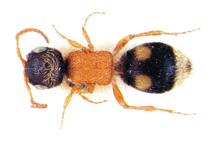Abstract
Nine species of Palaearctic Myrmillinae with females bearing two round spots on the second metasomal tergite, currently assigned to two genera, Blakeius Ashmead, 1903 and Liomutilla André, 1907, are revised and their phylogenetic relationships are investigated. The cladistic analyses demonstrate that Blakeius is not strictly monophyletic but includes three distinct lineages: Blakeius s. str., containing three species, an additional two genera proposed as new (Bidecoloratilla Turrisi & Matteini Palmerini, gen. nov., with four species, type species Mutilla chiesi Spinola, 1839, and Bimaculatilla Turrisi & Matteini Palmerini, gen. nov., including only type species Myrmilla invreai Suárez, 1958), and the monotypic genus Liomutilla is nested within the former Blakeius. A new status is proposed for Bla. cobosi (Suárez, 1958), stat. nov., and the specific status of Bid. iberica (Suárez, 1958), is confirmed. New combinations are proposed for Bim. invreai (Suárez, 1958), comb. nov. (from Myrmilla), Bid. chiesi (Spinola, 1839), comb. nov., Bid. iberica (Suárez, 1958), comb. nov., Bid. leopoldina (Invrea, 1955), comb. nov. Bid. negrei (Suárez, 1958), comb. nov. (all from Blakeius). Lectotypes are designated for Myr. otini Giner Marí, 1959 (♀) and Myr. leopoldina Invrea, 1955 (♂). Redescriptions of all treated taxa, based also on material belonging to the type series, are provided, along with illustrations of both sexes. Based on extensive material of relevant museum collections and personal collections, the distributions of all treated taxa are revised and illustrated through distributional maps. A revised key to genera of the subfamily Myrmillinae of the Palaearctic Region is given.

